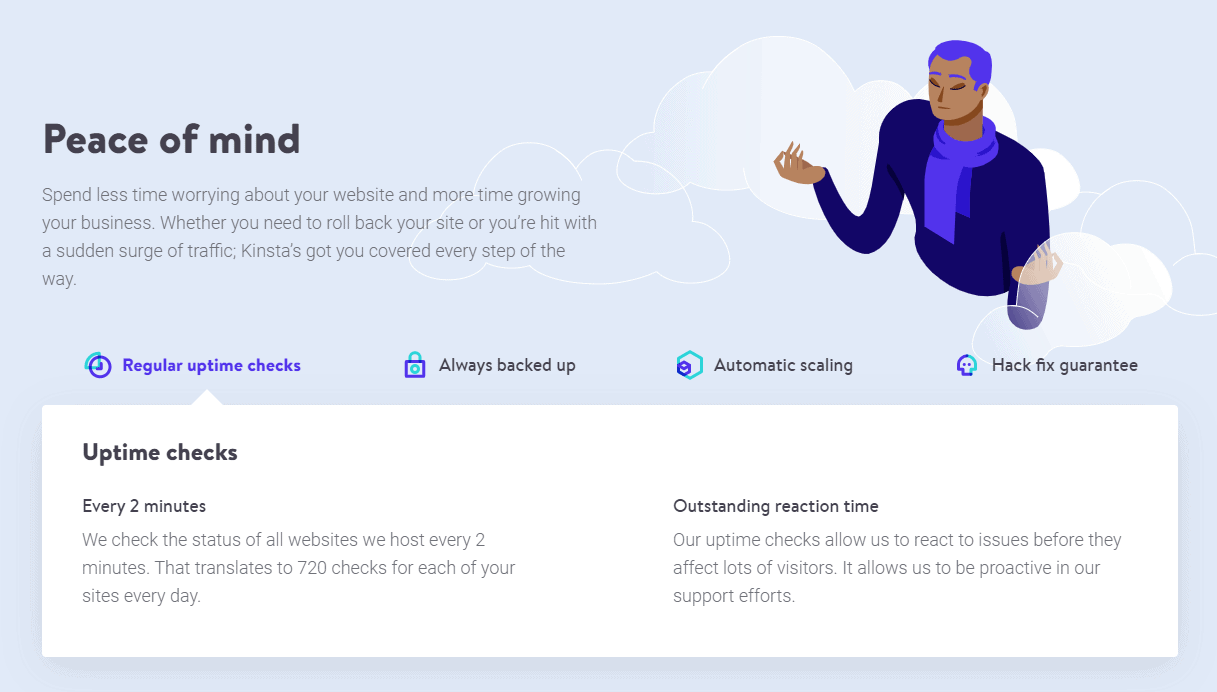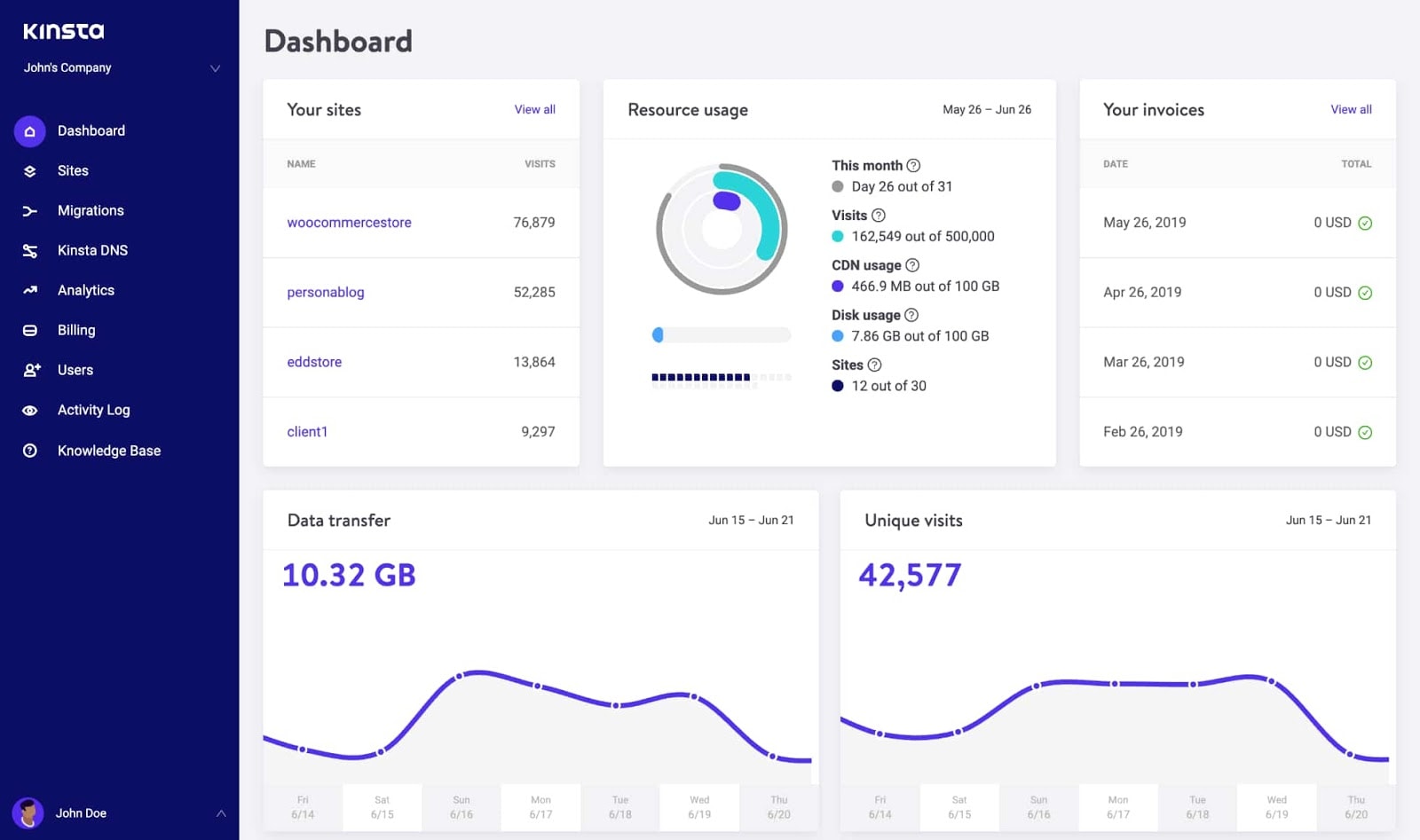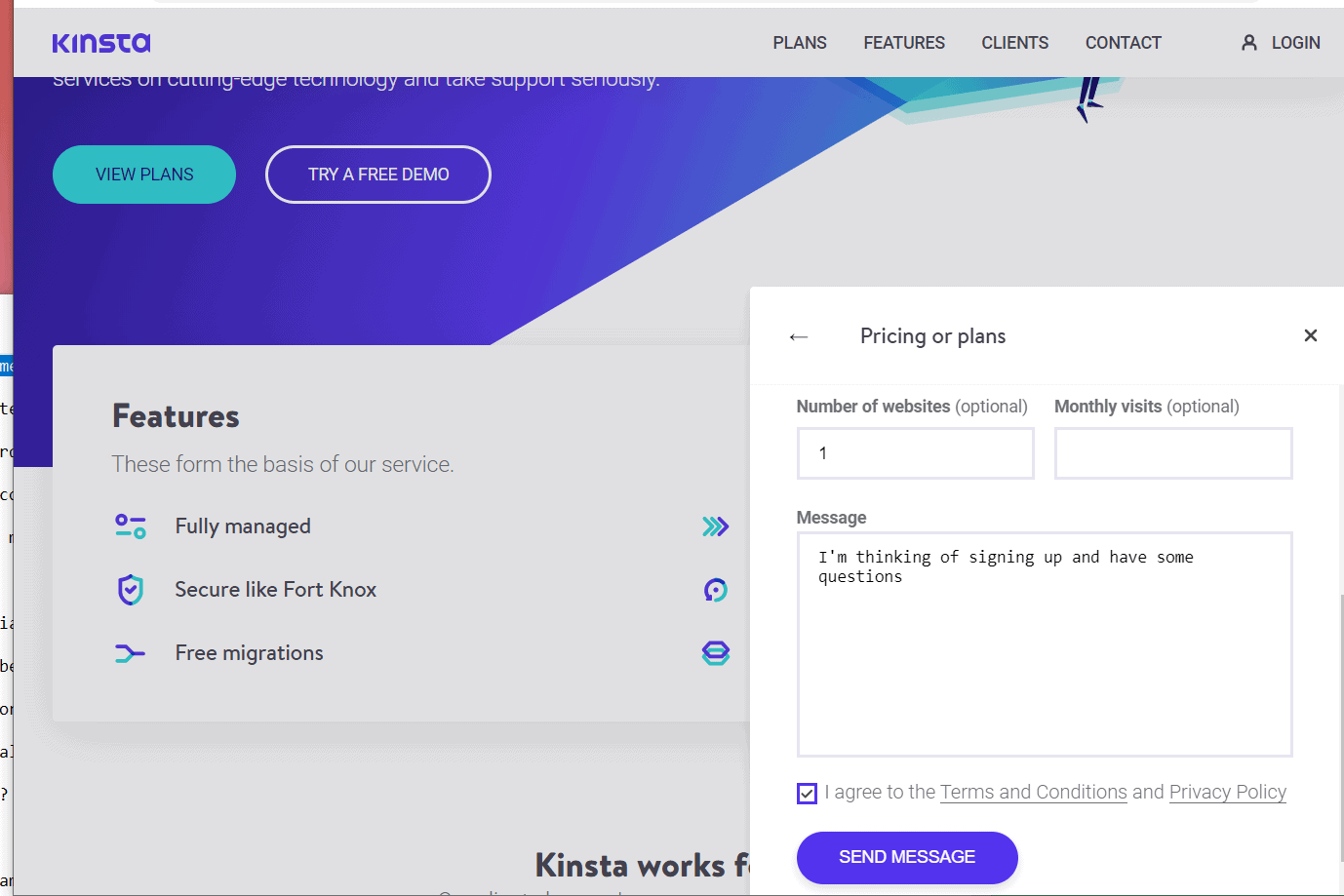Kinsta is all about managed hosting for WordPress. The key word there is “managed,” as in, all of the hosting and server setup is taken care of for you.
It’s a cloud-based service build on top of the Google Cloud Platform, so the servers are fast, and redundancy is built in. There’s a support team that is, according to the marketing claims at least, fully fluent in WordPress, in case you need some help.
Sound too good to be true? Well, it’s not. It’s just expensive.
That’s right, everyone, this is the holy grail of WordPress hosting. It’s fast, it’s pretty, and it can make your wallet reconsider its life choices. For context, that means Kinsta is charging $35.00 per month for their cheapest plan, while Hostinger only charges $1.99. For the money that Kinsta is charging, I’d definitely expect amazing WordPress hosting.
To find out just how amazing it is, I hosted a test website with Kinsta for a few months, as part of Website huge web host comparison project. Read on and find out if Kinsta is right for you and your bank account.

Kinsta Takes the “Managing” Part Seriously
Kinsta wants to be your website’s overbearing helicopter parent. This approach to management might not be so great for people, but it’s fantastic for websites and most dogs. All plans come with website uptime checks that happen every 2 minutes, a guarantee that your website will be fixed if it gets hacked, and automatic server scaling.
I’ll get into the server scaling more down below.
There are also lots of WordPress-specific tools, a dashboard for managing multiple sites at once, detailed site statistics and analytics… but no cPanel. The only CMS you can run is WordPress, so that’s to be expected, really.
Resource-wise, the Starter plan comes with 1 website, 10GB of disk space, and enough bandwidth for an estimated 20,000 monthly visitors. This is a fantastic start, and Kinsta is good about helping you make the most of your resources.
The higher-tier plans give you more websites and more resources, up to a maximum of 20 websites, 400,000 visits, 50GB of space. Other than that, all plans are identical.
There’s no “secret boost” that’s only available with the more advanced plans, and no weird pricing tier system where you have to pay for things you don’t need, just to get the one feature you do require. (Nearly all shared hosting services use this tactic, constantly hiding the best features behind paywalls and upgrades. It’s not cool.)
But it’s worth reiterating that Kinsta is no shared hosting service. Not at all. It’s completely cloud-based and runs its own optimized server technology. As such, its premium pricing comes with just about everything you’ll need. There’s no need to weasel more money out of you when you’re already paying a lot.
As expected from a premium service, you get SSL certificates automatically. SSL makes sure that everything your users do on your site is encrypted, which is good for security, good for avoiding lawsuits, and even good for an SEO bump from Google. There’s literally no downside to this.
You get fully automatic daily backups by default, and you can make your own backups on demand whenever you like. This is a feature that should be included by default with every host, but it’s not.
Performance-improving caching options are also included, so static websites can go from heavy to minimized in no time, consuming less of your resources and loading faster for visitors.
Global Google Cloud Data Centers (Are a Good Thing)
Speaking of loading fast…
Old school hosts (i.e. 99% of hosts) maintain their own data centers, or lease out space in an existing data center. This used to work pretty well, but hardware gets old fast, and today, almost all shared hosts provide hosting on top of machines from the early 2010s at best, and the late 2000s at worst.
Just a reminder for us adults: that’s 20-year-old hardware. It’s almost old enough to drink in the US, and plenty old enough to drink anywhere else. This might explain why hardware that old starts to make terrible decisions.
Not only that, most hosts only operate 2-3 data center locations, usually in the US west coast and in the Netherlands, sometimes also in Singapore. That means that faraway visitors – and let’s be honest, California is super far away from NY – will be treated to slow speeds and a bad time.
Kinsta doesn’t maintain its own data centers, but instead uses Google’s state of the art, super performing cloud data centers to house its WordPress platform. That means you not only get the best, newest hardware to power your project, but you have dozens of choices regarding server locations.
Kinsta has 7 US data centers and a total of 24 global ones. Zurich, São Paulo, Sydney, Seoul, Tokyo, Taiwan, and more are all available, making Kinsta the best possible host for audiences in those areas.
Kinsta Has Its Own CDN
So a CDN, also known as a Content Delivery Network, is a system that will take cached copies of your website, and deliver it to even more data centers, so you can take advantage of more than one server location at a time.
While many hosts will allow you to integrate your site with a third-party CDN, it’s usually Cloudflare, and it’s usually the free plan. That presents you with some considerable limits, unless you shell out the money for Cloudflare’s better plans.
Kinsta’s own CDN is fast, and included in the price you’re already paying. What’s not to love?
Auto-scaling CPU and RAM Keeps Your Site Going Through High Traffic
The beauty of a cloud platform is that resources can easily be scaled to meet a growing demand. Kinsta auto-scales your CPU and RAM, instead of arbitrarily limiting it, meaning that if your project ends up requiring more power, or if you’re enjoying a visitor barrage, your website will be able to handle the traffic.
Other hosts simply crash or send you an email saying “pay muuuuch more and maybe your hosting plan can handle the traffic.” With them, it rarely does.
Just to compare, the maximum amount of RAM you can get from Kinsta is estimated to be around 10 times what competitors provide. And that, folks, is the difference between a WooCommerce store that handles dozens of simultaneous visitors and makes you a ton of money, and one that crashes and makes a few measly sales a month, with close to no returning customers.

It’s (Mostly) Easy
Signing up was fast and I got activated immediately, which also puts Kinsta way above the many hosts that mark you as a potential fraudster, and delay your ability to use the service by two weeks. (*cough* Liquid Web *cough*)
The general experience is smooth, pleasant, and a breath of fresh air… with one or two caveats. Let’s have a look at the good and the bad.
The Custom Control Panel Gives You Exactly What You Need
… and no more. Kinsta has developed its very own WordPress platform and has taken it upon itself to build and configure every setting to already fit your WordPress needs. As such, there’s no need for a fully-fledged hosting panel – it’s not like you can use it for things other than WordPress anyways.
So again, there’s no cPanel.
There Was a Slight Problem with My Domain Name, Though
The one issue came with domain and DNS settings. They weren’t preconfigured to work with my domain, which was hosted elsewhere. There was a long-winded guide about how to configure them and add the many needed records, but it didn’t seem to really work. I played around with it until I got things going, but there’s really no explanation as to why this wasn’t automatically done, as it is even with the most mediocre shared hosts.
Still, after that, everything was awesome again. There’s really nothing like using a panel that was developed by UX/UI geniuses that not only understand what you need, but also what you don’t. It was a real joy to use.
So, I ran my test website over a few months. Before I ran my tests, I asked the support team to give me advice on optimizing my site, to allow Kinsta to make the best first impression possible. And boy, did it make an impression.
BEST. HOST. EVER.
There’s really no need to mince words here. Fastest speeds in every possible test, leading the pack and then some. Competitors like Liquid Web come close, but Kinsta is an unstoppable beast.
I’m about to get unhealthily excited over more detailed statistics, and you can stay and read while I flatter Kinsta a whole bunch if you want. If you’d rather just skip to the Support section, I understand.
So I set up a proper WordPress one-page site at our site with HD images, JavaScript, and other typical things a working website would have. I used GTmetrix to test complete page loading times, Sucuri to test international (not complete) loading times, and UptimeRobot to see how long my site would actually stay up.
GTmetrix
The fastest time was a beautiful 0.8 seconds, the average was 1.2s, and the slowest time was a perfectly acceptable 1.6s. The accepted standard for paging loading speed is “keep it under 2 seconds.” If you go too far over that benchmark, people won’t load up Netflix while they wait, they’ll just go to a different site.
Some people never spent their childhood on dial-up, and it shows. Anyway, here’s what the fastest test results look like:
Sucuri
Sucuri tests how long it takes a page to load all over the world, via a number of different servers. The fastest average loading time was a stupidly fast 0.144 seconds, the average-average was 0.631s, and the slowest average loading time was 2.033s.
Now again, Sucuri doesn’t load pages in their entirety. It just measures how long it takes for the page to “get going,” as it were. Globally, Kinsta’s fastest performance reaches almost instant loading times (Sucuri loading times – not full page loads), beating out everybody else. Even the slowest location speed, on the other side of the world, is pretty neat. The average is phenomenal and is why Sucuri awarded my Kinsta website an A ranking.
Here’s one of the tests, so you get an idea of where the site loaded the fastest:
It’s really okay. Not amazing, but okay.
The pre-sales “chat box” ended up being a form that got sent as an email. I would’ve preferred to live chat, but I did get an answer pretty quickly, with an agent offering to schedule a pre-sales phone call.
I appreciate the effort, but I wanted to chat using my trusty keyboard. He didn’t answer when I asked if that was possible, and so our interaction ended with a whimper.

After signing up, the situation got much better. Kinsta has real 24/7 support through live chat and phone, and even through chat, I never ended up waiting for more than a minute. There’s a weird bug where sometimes the replies don’t show up, but refreshing solves that (so just refresh after one minute).
Not only that, this live chat saves your previous interactions, which allows you to continue working on an ongoing issue without having to re-explain everything and get thrown around between agents. This is a ticket system combined with live chat as it should be.
I wanted to test the support team’s limits, so I started asking web dev questions regarding WordPress. They remained attentive and guided me, step by step, through everything I wanted. When I asked for explanations about the CDN and the security tools, the agent immediately detailed what the tools provide and explained all important things regarding them.
Still, with Kinsta focusing squarely on hosting, there’s a limit to what they will do. My pleas for help with optimization got answered by “activate your Kinsta CDN” and “here’s a guide.”
After my experience with GreenGeeks, where the support agent spent an hour overhauling my entire site, I was a bit disappointed. And yet, Kinsta’s servers outperformed GreenGeeks by a huge margin. What do you need even the most dedicated support agent for, if almost everything is already optimized to work as well as possible?
Kinsta is a really expensive service. If you’re used to regular shared hosting, which sells for around $1-10 a month, we’re talking about increasing the price 3-30 times. However, that money goes somewhere.
Value-for-money-wise, this is a service far above the competition. Liquid Web is the only other service that comes close, and it’s also very expensive, albeit slightly cheaper than Kinsta.
There’s no funny pricing tier – you can pay monthly or yearly, and get a small discount for yearly.
Payments can only be made with credit cards (and all the usual suspects like Visa and Mastercard are here), but there’s no fraud detection system that makes your life miserable (*cough* I hate you Liquid Web *cough*). I would’ve liked to pay with PayPal, but for some reason, Kinsta seems very keen on sticking with credit cards.
Domains simply aren’t available through Kinsta, not for free and not for purchase. This cements Kinsta as a service that doesn’t look to make money off reselling extras to you. You pay for the service, and it’s the best service, but the domain is left up to you.
There are no hidden upsells, no hidden fees, and a 30-day money-back guarantee is available with all plans. But damn, it’s so expensive.
This is easy math (unlike actual math). Use WordPress, got the money, and need the power? Kinsta. Kinsta. Kinsta. Take a look at its best plans right now.
Don’t have the money, but need the power? Think about your life, investments, everything, and try to get that money. You won’t find this power anywhere else.
Really don’t have the money? Try a bargain-priced shared hosts. Hostinger and InterServer are my top recommendations, but don’t think for a moment you’ll be getting anything on the same level of what Kinsta provides.
